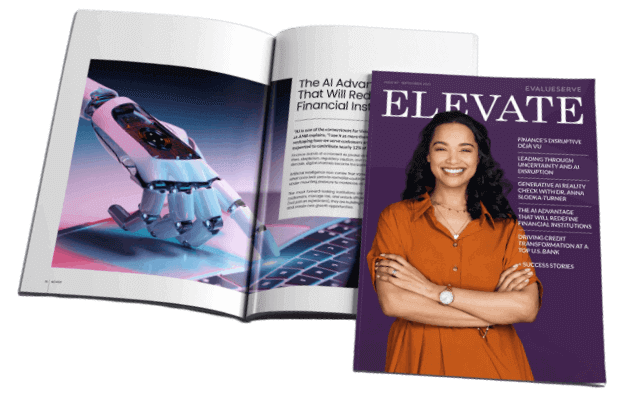In 2025, most financial institutions have budget earmarked for credit transformation—and rightly so. The pressure to make faster, smarter credit decisions while reducing cost and human effort is mounting across the board. But unlocking real transformation requires more than just giving the team access to chatbots. We know LLMs drive individual productivity, but where can they truly transform workflows? It takes a deep understanding of credit processes, the ability to work with existing technology, and strategic partnerships to build AI into the heart of decision-making.
At Evalueserve, we've been using our domain expertise to focus on very specific, high-impact use cases for generative AI. “Clients want faster decisions, real-time insights, and automation that works with legacy systems," stated Saikat Gupta, Head of Automation and Product for Financial Services at Evalueserve, in a recent webinar with Chartis Research.
Credit is a core focus area where we’ve built deep expertise working with global institutions across the lending lifecycle. For years, our teams have supported the creation of complex credit memos for lending teams. Now, with the rise of generative AI and domain-tuned agents, we’re helping clients transform this historically manual process into a scalable, intelligent, and high-ROI solution.
Partnering to Build the Future of Credit
When one of our global banking clients came to us with a challenge, we knew it was an opportunity to create something transformative. Their credit teams were overwhelmed by the manual effort required to produce detailed credit memos—each document stretching 50–60 pages for large corporates and SME portfolios. The process was time-consuming, error-prone, and too rigid to scale during peak cycles.
With our deep domain expertise and proven frameworks, we engineered a solution powered by generative AI agents—built for the financial services ecosystem, auditable by design, and tailored to the client’s exact templates. With a standard generative AI tool, analysts could feed specific prompts to a chat interface to draft pieces of a report. With agents, however, the entire end-to-end process can be automated, not only generating text and insights but also handling data extraction, validation, formatting, and integration across multiple systems. With this approach, all the analysts need to do is review and verify to ensure accuracy.
The AI-Driven Solution: Smart Agents Meet Real-World Credit Workflows
We knew from experience that the ability to rapidly create prototypes and customize for specific workflows and templates was key. “Lending processes can get really complicated, differing from client to client,” said Saikat Gupta. “Every bank has its unique layouts for a credit memo and specific financial spreading guidelines for adjusting the financials.”
The solution we created integrates seamlessly with our Spreadsmart platform, which already houses modules for financial spreading and covenant analysis. When a user initiates the creation or update of a memo, the AI first analyzes previous memos to understand available data, source references, and analytical context. From there, it enables dynamic configuration of memo sections and subsections—ensuring alignment with the bank’s specific structure.
What makes this solution uniquely powerful is its ability to combine structured and unstructured data. Structured inputs like adjusted financials flow directly from Spreadsmart or other internal systems, while unstructured content from filings, reports, and presentations provides context and rationale. Behind the scenes, a set of intelligent agents work iteratively—handling financial data extraction, narrative generation, validation, and reference tracing—powered by a gen AI pipeline using agentic RAG (Retrieval-Augmented Generation).
The entire process gives analysts control to review, drill into source documents, and even audit how the AI generated specific insights—like profitability commentary or liquidity trends. Flexible deployment options (including on-premise and LLM selection) and customizable templates ensure the platform can adapt to any institution’s unique needs. In addition, an embedded gen AI chatbot allows analysts to ask follow-up questions, explore trends, and derive borrower insights that go beyond static memo outputs.
The result? A templatized but interactive credit memo—ready for review, editable by humans, and responsive to evolving credit guidelines.
The Impact: Speed, Scale, and Real ROI
The results were nothing short of game-changing:
- 30–40% reduction in manual effort for first-draft creation
- Dramatically improved scalability during peak cycles
- Higher-quality outputs, tailored to each bank’s and each sector’s unique analysis format
- A system that’s not just fast, but also auditable and configurable
Perhaps most importantly, this was not a black-box solution. It was a human-in-loop process, where client relationship managers and Evalueserve credit analysts could trust the data, navigate insights with ease, and continue to ask critical questions.
Closing Thoughts: Building the Future, Together
This journey showcases how Evalueserve isn’t just providing a product—we’re building partnerships rooted in co-innovation. By combining our expertise with our clients’ unique workflows, we’re making AI work in the real world.
The future of credit transformation is here. It’s intelligent, quick, configurable, and deeply collaborative.
Talk to One of Our Experts
Get in touch today to find out about how Evalueserve can help you improve your processes, making you better, faster and more efficient.



